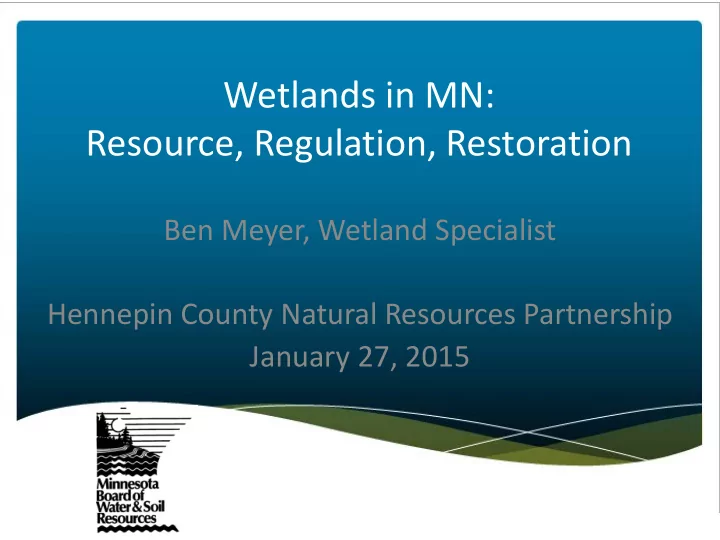

Wetlands in MN: Resource, Regulation, Restoration Ben Meyer, Wetland Specialist Hennepin County Natural Resources Partnership January 27, 2015
Wetlands What is a wetland? Definition (Federal Register): Those areas inundated or saturated by surface or ground water at a frequency and duration sufficient to support, and that under normal circumstances do support, a prevalence of vegetation typically adapted to life in saturated soil conditions.
Wetlands Definition (cont.) Wetlands generally include swamps, marshes, bogs and similar areas. Wet meadows, sedge meadows, floodplains, fens, ephemeral (seasonal), etc.
Wetlands What is a wetland? Three parameter approach (1987 Corps Manual): Hydrology Vegetation Soils Need all three!
Wetlands Diagnostic characteristics. • Hydrology – permanent or periodic inundation at < 6.6 ft. or saturated to the surface at some time during the growing season.
Wetlands Diagnostic characteristics. • Soils – Classified as hydric or possess characteristics that are associated with reducing conditions (lack of oxygen). Hydric soil (USDA) “a soil that formed under conditions of saturation, flooding or ponding long enough during the growing season to develop anaerobic conditions in the upper part”
Wetlands Diagnostic characteristics. • Vegetation – plants adapted to have the ability to grow, compete, reproduce and persist in anaerobic soil conditions.
Wetlands Why important. • Functions – Water quality improvement, flood attenuation, habitat, aesthetics, biological productivity, etc. • Values – Importance of one or more functions to society
Wetlands Historical context.
Wetlands Historical context. <50% Wetlands Remaining!
Wetlands South Heron Okabena Lake I-90
Wetlands Regulations • Corps of Engineers, CWA Section 404 • DNR Public Waters • BWSR Wetland Conservation Act • Local Ordinances • Watershed District Rules • NRCS, USFWS, EPA
Wetlands Board of Water and Soil Resources Mission: Improve and protect Minnesota’s water and soil resources by working in partnership with local organizations and private landowners. www.bwsr.state.mn.us
Wetlands BWSR Focus is on: • 78% of state which is in private land ownership. • Local governments as the principal land-use authorities and the most connected to the citizens. • Long-term conservation that cannot happen without private landowners and local governments being engaged and responsible.
Wetlands Agency Organization 17-member board: - local governments (9) - citizens (3) - state agencies (5) 100 Staff in 8 offices Statutorily linked to: 91 SWCDs 46 Watershed Districts 87 Counties 23 metro WMOs
Wetlands Select BWSR Programs: • Local Water Management & Oversight: County, SWCD, Watershed District, WMO • Re-invest in Minnesota (RIM) • Drainage Assistance • Grants: Wetlands, Shorelands, Septic • Clean Water Legacy: Impaired Waters cleanup • Wetland Conservation Act • Wetland Banking; including Public Roads
Wetlands MN Wetland Conservation Act (WCA) • State law first passed in 1991 that regulates activities in wetlands (draining, filling, excavation). Contributes to goal of no-net-loss of wetlands by avoiding impacts and replacing them if unavoidable.
Wetlands MN Wetland Conservation Act (WCA) • Board of Water and Soil Resources (BWSR) – Overall administration, training, rules – Oversight and Appeals • Local Government Units (LGU) – Implementation • Technical Evaluation Panel (TEP): BWSR + LGU + SWCD – Technical advice to decision • DNR – Enforcement, violations
Wetlands MN Wetland Conservation Act (WCA) • Goal of no-net-loss of wetlands by avoiding impacts and replacing them if unavoidable. • System of statewide private and public banks • Replacement ratios • Banking “actions eligible for credit”
Wetlands Wetland Replacement • Mitigation/Banking “actions eligible for credit” • Restoration priority • Larger sizes • Functional lift (quality gain)
Wetlands Wetland Replacement • Mitigation/Banking “actions eligible for credit” – Upland Buffer – Restoration of completely filled or drained – Restoration of partially filled or drained – Veg. restoration of farmed – Creation (less preferred)
Wetlands BSAs
Wetlands Wetland Bank Map
Wetlands Wetland Replacement • Examples – Private – Road
Wetlands Wetland Restoration/ Banking Example 1 Dayton, MN Private
Wetlands
Wetlands
Wetlands
Wetlands
Wetlands Wetland Restoration/ Banking Example 1 Dayton, MN
Wetlands
Wetlands Wetland Restoration/ Banking Example 1 Dayton, MN
Wetlands Wetland Restoration/ Banking Example 2 Cokato, MN BWSR Road Bank
Wetlands
Wetlands
Wetlands
Wetlands
Wetlands
Wetlands
Wetlands Golden Valley Minnaqua Example
Wetlands Golden Valley Minnaqua Example
Wetlands Wetland Restoration Integrated Design
Wetlands Designed for natural function in perpetuity Monitoring Initial monitoring required for up to 5 years • Periodic checks/maintenance • Easements • Recorded restrictions • Conservation easements Management and maintenance
Wetlands Summary: Resource, Regulation, Restoration • Important resource • Highly manipulated landscape • Historic drainage, identify sites, restoration fits in landscape/land use • All wetlands are regulated • Development/Restoration/Banking opportunities exist, incentives, etc.
Wetlands Thank you. Ben Meyer ben.meyer@state.mn.us
Recommend
More recommend